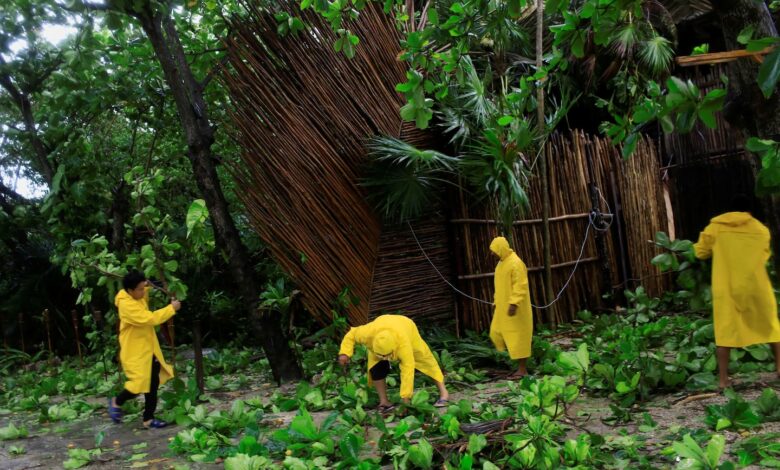Hurricane Beryl hits Mexico’s Yucatan Peninsula as risk grows for Texas

[ad_1]
Concern is growing in Texas, where the National Hurricane Center is now forecasting the storm to strike between Sunday night and Monday. By then, Beryl will probably have regained hurricane status and will be intensifying right up to the point of moving ashore.
“There is an increasing risk of hurricane-force winds, life-threatening storm surge and flooding from heavy rainfall in portions of northeastern Mexico and the lower and middle Texas coast late Sunday and Monday,” the Hurricane Center wrote Friday.
Computer model simulations run Friday showed the area around Corpus Christi as a particular area of concern, although shifts in Beryl’s predicted track — either north or south — are possible. In addition, hurricane impacts can occur hundreds of miles away from where the center of the storm strikes.
Beryl swept ashore in Mexico around 6 a.m. just north of the beach resort of Tulum, whipping palm trees with 100 mph winds and pounding communities with rain. There were widespread blackouts, but no casualties were reported, according to Laura Velázquez, the national coordinator of civil protection.
Speaking from the region, she told reporters at President Andrés Manuel López Obrador’s morning news conference that roughly half of Tulum and half of the territory of Isla Mujeres, another tourist destination, had lost power. Electricity was also knocked out in several neighborhoods on the island of Cozumel.
The strong winds toppled trees and some electricity poles, but no one was killed or seriously injured, Velázquez said. Authorities rescued several people from flooded homes.
The international airport in Cancún canceled nearly 300 flights, while the airport in Tulum isn’t scheduled to reopen until Sunday.
Authorities urged residents and tourists to stay indoors because of downed power lines and trees.
The storm didn’t cause significant erosion of the region’s famed white-sand beaches, said Gov. Mara Lezama, citing reports from the hotel association. The hurricane also didn’t appear to cause major damage to five-star hotels but pummeled the flimsy homes of poorer residents of the coastal communities. On TikTok, people described how the winds stripped roof panels from modest homes.
“The winds rose last night, and our electricity went out,” said a man who identified himself as John, in Playa del Carmen, south of Cancún. “At dawn, the roof panels flew off the house of our neighbors in front of us. The [car] alarms haven’t stopped blaring.”
Leslie Diaz, posted a video on TikTok from Playa del Carmen shortly before the hurricane arrived. Her dog was burrowing under the blankets of the bed, in fear.
“It’s nearly 5 a.m. and there’s a horrible rumbling,” she said, as winds whistled in the background. “It hasn’t yet touched land, but it’s already very strong.”
The region is accustomed to hurricanes; in 2005, Hurricane Wilma caused eight deaths and billions of dollars in damage. So Mexican authorities took ample precautions this time, sending nearly 10,000 army, navy and national guard forces to help victims and to patrol rain-slicked streets.
With the storm on a collision course with the west coast of the Gulf of Mexico, the Hurricane Center plans to issue tropical storm, storm surge and hurricane watches for portions of Texas and northeast Mexico.
As of 2 p.m. Eastern time, the center of Beryl was over the northwest Yucatán Peninsula, or about 650 miles east-southeast of Brownsville, Tex., while sweeping to the west-northwest at 15 mph. Maximum winds had diminished to 70 mph, making Beryl a tropical storm. Weakening will continue until the storm reenters the ocean.
As Beryl tracks west-northwest through the Gulf of Mexico into the weekend, where water temperatures are in the mid-80s, the Hurricane Center is predicting at least gradual strengthening.
Model simulations vary on how quickly Beryl will restrengthen and to what extent.
Hurricane-specific models largely do not project rapid intensification. But larger-scale models such as the American and the European are calling for what the Hurricane Center describes as “significant deepening as Beryl approaches the coastline.” Abnormally warm waters and favorable high-altitude wind patterns could fuel swift strengthening.
But Beryl could be inhibited from restrengthening if the storm’s core is too disrupted and can’t rebuild itself after crossing the Yucatán.
Another wild card is exactly where Beryl will come ashore. Models project Beryl will parallel the coast of Tamaulipas, Mexico, and Texas on approach, meaning small wobbles in the track will have dramatic implications in ultimate landfall location.
A significant influence on the track forecast is a dip in the jet stream over the central United States, which will try to tug Beryl northward. But when, and where, that tug happens remains to be seen. If Beryl is stronger, it is more probable it will be drawn north toward the lower and middle Texas coast but, if it is weaker, it would have a better chance of striking northeast Mexico.
For those in northern Mexico or along the lower and middle Texas coast, it is a good time to begin preparing for a possible hurricane impact. A landfall in the Category 1 or 2 range is most likely, but a major, Category 3 hurricane isn’t entirely impossible if Beryl intensifies faster than expected. “Interests in these areas should closely monitor updates to the forecast,” the Hurricane Center wrote.
The Weather Service office in Brownsville, Tex., is predicting at least 4 to 6 inches of rain in the region and up to 10 inches.
“Rainfall is not the only hazard that will be associated with Beryl,” the Weather Service wrote. “High risk of rip current[s], storm surge, damaging to destructive coastal wave action including coasting flooding, high surf, and tropical storm force winds. Beryl could bring some weak short lived tornadoes to the area as well.”
The Weather Service office in Corpus Christi, Tex., also urged residents to begin preparations, highlighting the potential for coastal flooding, a high rip current risk and heavy rainfall.
Beryl became the first hurricane of the 2024 season and the earliest-forming Category 5 on record in the Atlantic on Monday night. The storm — fueled by record-warm ocean waters — broke benchmarks for its strength and the rate at which it intensified so early in the season, stunning meteorologists.
The storm first hit Grenada, St. Vincent and other Caribbean islands Monday, leaving behind widespread destruction — particularly on the Grenadian islands of Carriacou and Petite Martinique — and killing at least five people. Three additional deaths were reported in Venezuela.
On Carriacou, home to about 7,000 people, the hurricane wreaked “total devastation all around,” said Allison Caton, 50, owner of Paradise Beach Club, a restaurant and bar on Paradise Beach that was destroyed. Many of the island’s residents are now living in makeshift shelters in schools.
On Wednesday, the storm scraped by Jamaica’s southern coast, producing flooding rains and wind gusts over 80 mph that destroyed homes and toppled trees and power lines. At least two deaths were reported and roughly 65 percent of Jamaica Public Service Co. customers — about 400,000 households — were left without power as of Thursday, the BBC reported.
The storm brought strong winds and heavy rain to the Cayman Islands Wednesday night before barreling toward the Yucatán Peninsula.
Gabriela Martinez, Jason Samenow, Amanda Coletta, Kim Bellware, Samantha Schmidt and Anumita Kaur contributed to this report.
[ad_2]
Source link




